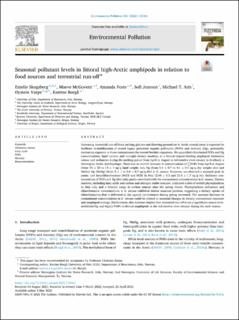| dc.contributor.author | Skogsberg, Stina Linnea Emelie | |
| dc.contributor.author | Mcgovern, Maeve | |
| dc.contributor.author | Poste, Amanda | |
| dc.contributor.author | Jonsson, Sofi | |
| dc.contributor.author | Arts, Michael T. | |
| dc.contributor.author | Varpe, Øystein | |
| dc.contributor.author | Borgå, Katrine | |
| dc.date.accessioned | 2022-07-12T11:38:09Z | |
| dc.date.available | 2022-07-12T11:38:09Z | |
| dc.date.created | 2022-05-10T15:37:06Z | |
| dc.date.issued | 2022 | |
| dc.identifier.citation | Environmental Pollution (1987). 2022, 306, 119361. | en_US |
| dc.identifier.issn | 0269-7491 | |
| dc.identifier.uri | https://hdl.handle.net/11250/3004671 | |
| dc.description.abstract | Increasing terrestrial run-off from melting glaciers and thawing permafrost to Arctic coastal areas is expected to facilitate re-mobilization of stored legacy persistent organic pollutants (POPs) and mercury (Hg), potentially increasing exposure to these contaminants for coastal benthic organisms. We quantified chlorinated POPs and Hg concentrations, lipid content and multiple dietary markers, in a littoral deposit-feeding amphipod Gammarus setosus and sediments during the melting period from April to August in Adventelva river estuary in Svalbard, a Norwegian Arctic Aarchipelago. There was an overall decrease in concentrations of ∑POPs from April to August (from 58 ± 23 to 13 ± 4 ng/g lipid weight; lw), Hg (from 5.6 ± 0.7 to 4.1 ± 0.5 ng/g dry weight; dw) and Methyl Hg (MeHg) (from 5 ± 1 to 0.8 ± 0.7 ng/g dw) in G. setosus. However, we observed a seasonal peak in penta- and hexachlorobenzene (PeCB and HCB) in May (2.44 ± 0.3 and 23.6 ± 1.7 ng/g lw). Sediment concentrations of POPs and Hg (dw) only partly correlated with the contaminant concentrations in G. setosus. Dietary markers, including fatty acids and carbon and nitrogen stable isotopes, indicated a diet of settled phytoplankton in May–July and a broader range of carbon sources after the spring bloom. Phytoplankton utilization and chlorobenzene concentrations in G. setosus exhibited similar seasonal patterns, suggesting a dietary uptake of chlorobenzenes that is delivered to the aquatic environment during spring snowmelt. The seasonal decrease in contaminant concentrations in G. setosus could be related to seasonal changes in dietary contaminant exposure and amphipod ecology. Furthermore, this decrease implies that terrestrial run-off is not a significant source of re-mobilized Hg and legacy POPs to littoral amphipods in the Adventelva river estuary during the melt season. | en_US |
| dc.language.iso | eng | en_US |
| dc.publisher | Elsevier | en_US |
| dc.rights | Navngivelse 4.0 Internasjonal | * |
| dc.rights.uri | http://creativecommons.org/licenses/by/4.0/deed.no | * |
| dc.title | Seasonal pollutant levels in littoral high-Arctic amphipods in relation to food sources and terrestrial run-off | en_US |
| dc.type | Peer reviewed | en_US |
| dc.type | Journal article | en_US |
| dc.description.version | publishedVersion | en_US |
| dc.rights.holder | © 2022 The Authors | en_US |
| dc.source.pagenumber | 11 | en_US |
| dc.source.volume | 306 | en_US |
| dc.source.journal | Environmental Pollution (1987) | en_US |
| dc.identifier.doi | 10.1016/j.envpol.2022.119361 | |
| dc.identifier.cristin | 2023200 | |
| dc.relation.project | Norges forskningsråd: 268458 | en_US |
| cristin.ispublished | true | |
| cristin.fulltext | original | |
| cristin.qualitycode | 1 | |

